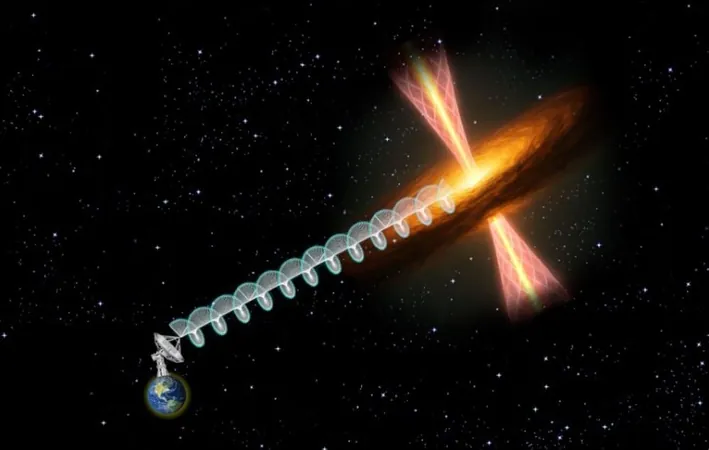
Astronomers Make Groundbreaking Discovery of Unique Magnetic Field Surrounding Massive Young Protostar
2025-07-18
Author: Siti
A Cosmic Breakthrough: Unveiling Magnetic Mysteries
Stargazers and astronomers are buzzing with excitement over a groundbreaking discovery in the cosmos: a massive young protostar, known as IRAS 18162-2048, has been found to possess an unusual magnetic field characterized by distinct circular polarization (CP). This remarkable finding sheds light on star formation and evolution, an area of deep intrigue in astrophysics.
The Luminous Realm of Young Stars
Young stars are the rockstars of the universe, glowing with unparalleled brightness and exhibiting extreme activity. With powerful magnetic fields and stellar winds, these celestial giants are known to launch jets of material at incredible speeds. Such jets are crucial to understanding how these stars interact with their surroundings and evolve over time.
A Historic Detection of Circular Polarization
In a study released in *The Astrophysical Journal Letters*, researchers led by Amal G. Cheriyan from the Indian Institute of Space Science and Technology have made history by detecting CP around IRAS 18162-2048, the first of its kind for such a massive protostar. Using the National Radio Astronomy Observatory’s Karl G Jansky Very Large Array, the team captured these elusive magnetic signals.
The Significance of Magnetic Fields in Star Formation
Measuring polarization helps astronomers estimate the strength of magnetic fields in star-forming systems, a vital piece of the cosmic puzzle. While lower-mass protostars have provided insights, the mystery of magnetic fields around massive protostars like IRAS 18162-2048 has long evaded scientists.
Why Massive Protostars Matter
Massive protostars are particularly captivating because of their overwhelming influence on their environment. With their intense luminosity and stellar winds, they can shape nearby interstellar gas and inhibit star formation, carving out bubbles in the cosmic dust. IRAS 18162-2048 stands out, driving the most powerful and luminous jet known in our galaxy, the HH 80-81 jet, a dazzling display of cosmic energy.
Linking Protostars to the Cosmos
Previously detected magnetized jets from the HH 80-81 Herbig-Haro object hinted at the magnetic capabilities of protostars, but the current findings open new doors to understanding how these massive stars evolve. Interestingly, the research connects CP detection in protostars to similar findings in black holes, suggesting a profound relationship between these celestial giants.
Insights and Implications for Astrophysics
The potential magnetic fields of massive stars like IRAS 18162-2048 may be remnants from earlier stages of stellar life, theorized to be woven from interstellar medium structures. Astrophysicists propose that as molecular clouds collapse into protostars, these magnetic fields are intensified, leading to the compelling magnetic signatures we've observed.
A Step Toward Understanding Stellar Jet Mechanisms
The discovery opens new avenues for research into the mechanisms behind jets emitted from stars and black holes, suggesting universal principles governing their behavior. The findings could reshape our understanding of how stars like IRAS 18162-2048 evolve, ultimately influencing the future of star formation models.
The Future of Magnetic Stars?
As researchers delve deeper, IRAS 18162-2048 could emerge as a precursor to a highly magnetic star, potentially revolutionizing our grasp of stellar magnetism in the universe. This groundbreaking research not only provides a deeper understanding of massive stars but also highlights the complexities of stellar formation, continuing to thrill astronomers and cosmic enthusiasts alike.




 Brasil (PT)
Brasil (PT)
 Canada (EN)
Canada (EN)
 Chile (ES)
Chile (ES)
 Česko (CS)
Česko (CS)
 대한민국 (KO)
대한민국 (KO)
 España (ES)
España (ES)
 France (FR)
France (FR)
 Hong Kong (EN)
Hong Kong (EN)
 Italia (IT)
Italia (IT)
 日本 (JA)
日本 (JA)
 Magyarország (HU)
Magyarország (HU)
 Norge (NO)
Norge (NO)
 Polska (PL)
Polska (PL)
 Schweiz (DE)
Schweiz (DE)
 Singapore (EN)
Singapore (EN)
 Sverige (SV)
Sverige (SV)
 Suomi (FI)
Suomi (FI)
 Türkiye (TR)
Türkiye (TR)
 الإمارات العربية المتحدة (AR)
الإمارات العربية المتحدة (AR)